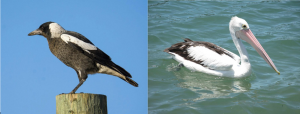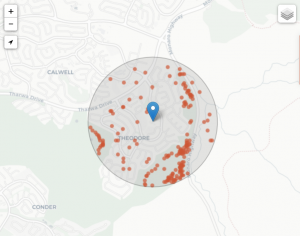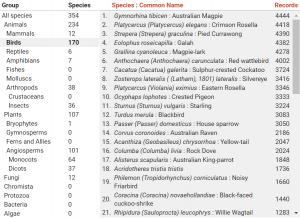Introduction
Show images of common local birds to start. For instructions on how to find what’s in your area and species images, see User Guide 1 – Finding the species located in your area and User Guide 6 – Finding information about a species. You may like to use the common birds pictured below as a starting point.

Starting a discussion
Questions:
What birds have you seen in the school yard? If you don’t know the name of the bird, describe it. Where did you see them? What time of day did you see them? What were the birds doing when you saw them? What about in your backyard? What about in the park? Were they making any noise? Were there more of one type of bird than another?
Note the names, places etc. on the board.
Use the Atlas of Living Australia to see what sorts of birds have been sighted in the area. See User Guide 1 – Finding the species located in your area.

Look at the ALA’s map of the schoolyard – What do you use maps for? What can you see on this map? What use might this map be for scientists? What sorts of other things might scientists use maps for?
Look at the birds on the list. The list will look like the one below.

Questions:
Has anyone seen any of these birds? Are there any common birds you’ve seen that are missing from the list?
Based on the discussion and ALA information, record in a table what birds they think they will see on a walk around the school yard. Include how many and whether they will be on the ground, in the sky or in a tree. (See Activity 1 – Predicted Birds Table)
Go outside
Gathering data
Walk students through the school yard and use another table to gather data about the birds they see. Discuss with students the best time of the school day to go and how they will need to behave to get the most information. Ask students to take digital photographs of some of the birds they see. Record the observations in a table (Activity 2 – Birds I saw in the schoolyard) and ask students to take as many notes as they can about the birds they see.
Then
Using the data
You could record the sightings in the Atlas of Living Australia via iNaturalist Australia (See User Guide 4 – How to log a sighting). The students will then be able to see their sightings appear as dots on the map.
Students could share and discuss their data and represent it on a bar graph. See Activity 3 – Draw a graph of birds seen in the school yard or Activity 4 – Use Excel to graph numbers of birds in the school yard.
Questions:
Did you see the birds that you predicted you would see? Why/why not?
What are some similarities between the birds that you saw? What are some differences? What are some things all birds have in common? Complete Activity 5 – Venn diagram using features of two different birds.
Further activities
As an extension activity, you might like to:
- Complete a walk through nearby bushland/parkland to gather more data. Make observations of the birds that were seen there and take photos. You could also record observations – Activity 2 – Birds I saw in the schoolyard. Were there any different birds to what was seen in the school yard? Why/why not? Were there any more or less birds? Why/why not?Record these sightings in the Atlas of Living Australia via iNaturalist also. (See User Guide 4 – How to log a sighting.)
Or
- Draw a map of the school yard. Like the ALA map, show the points where you saw individual birds. See Activity 6 – Draw a school yard map
There are many activities that cover the concept of Living and non-living things in an environment. One of the ones we recommend is from the Australian Science Teachers Association http://scienceweb.asta.edu.au/years-3-4/unit2/overview/yr34-unit2-overview.htm. Once the students have completed the Living or non-living lessons there, they can use the map that was drawn for Activity 6 to label living and non-living things in the school yard.
Now the students have a lot of knowledge of the birds in the school yard and where they are found, they could complete Activity 7 – Letter to principal about school yard plans.
Available activities:
- Activity 1 – Predicted Birds Table
- Activity 2 – Birds I saw in the schoolyard
- Activity 3 – Draw a graph of birds seen in the school yard
- Activity 4 – Use Excel to graph numbers of birds in the school yard
- Activity 5 – Venn diagram using features of two different birds
- Activity 6 – Draw a school yard map
- Activity 7 – Letter to principal about school yard plans